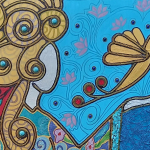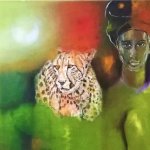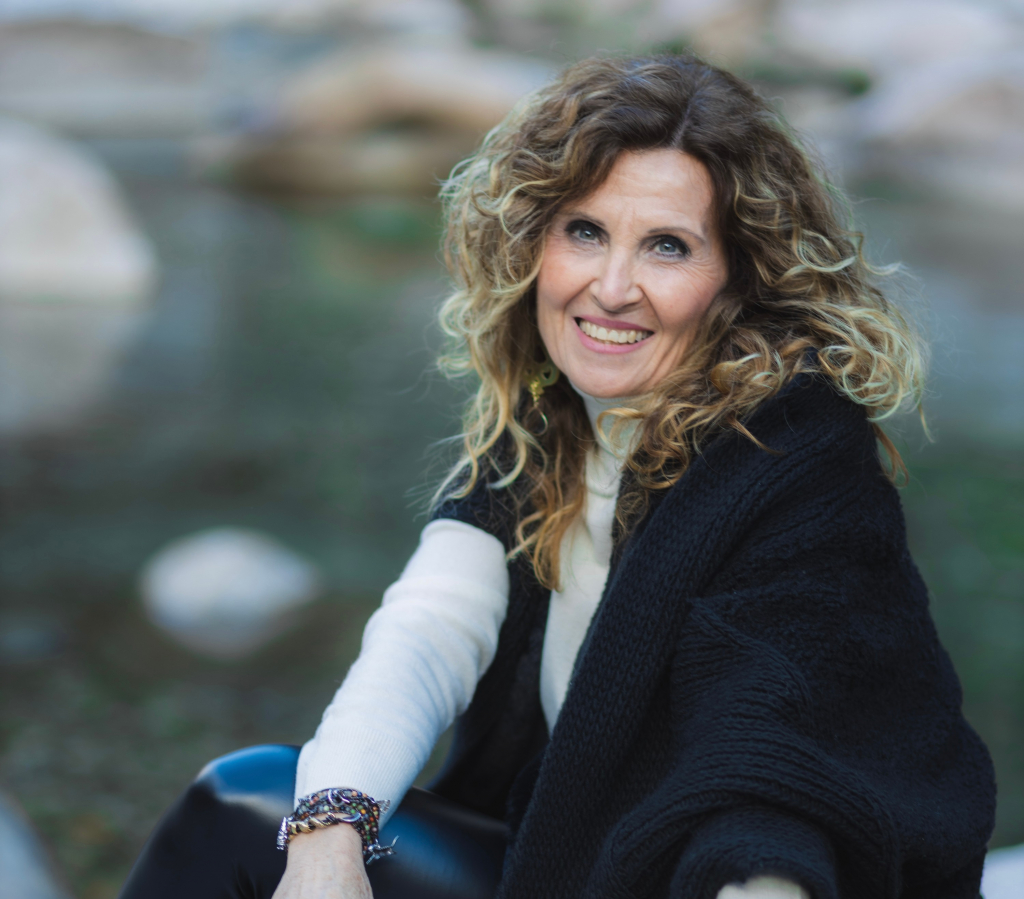
La scelta di vivere immersa nella natura, sulle sponde del lago di Lugano, le ha permesso di porsi in posizione di ascolto nei confronti della sua interiorità, quella che la induceva a cercare una via d’uscita rispetto alla logica e alla rigidità del suo ruolo di professionista finanziaria, per correre verso un approccio più spirituale, più predisposto alla riflessione e all’attenzione nei confronti di tutto ciò che sfugge alla mente e all’ordine per entrare nell’affascinante e coinvolgente mondo del caos. È stato il silenzio dei luoghi in cui abita, la tranquillità delle acque su cui si specchiano le montagne, a indurla a liberare il suo lato creativo, così come quello poetico che nella sfera professionale non riuscivano a realizzarsi facendole percepire quella sottile insoddisfazione che prima o poi conduce verso una naturale inclinazione che non può restare inascoltata; malgrado la scoperta di un’indole sensibile e creativa però, Daniela Rebuzzi ha un approccio all’arte più riflessivo e analitico che non impulsivamente irruento dunque la tecnica che sceglie è quella dell’Informale Materico laddove la materia sembra costituire il mezzo attraverso il quale scompone la realtà osservata e la consistenza abituale per poi ricomporla secondo un suo schema emozionale ma anche meditativo, come se in qualche modo sentisse la necessità di mostrare all’osservatore, e in fondo anche a se stessa, quante siano le possibilità esistenti se solo si è capaci di uscire dal proprio univoco punto di vista, dalla linea retta su cui spesso l’individuo tende a incanalare la propria esistenza evitando di avventurarsi in sentieri diversi che potrebbero anche dimostrarsi migliori, malgrado la destabilizzazione iniziale. Ogni tipo di materiale costituisce per la Rebuzzi un canale espressivo, un modo per trasformare tutto in qualcosa di diverso dalla sua forma originaria, arricchendo di concetti oggetti poveri, presi dalla quotidianità dopo che il loro utilizzo si è esaurito, perché è esattamente da tutto ciò che è familiare che l’uomo contemporaneo può prendere spunto per accogliere una visione differente, può diventare consapevole che il significato attribuito dalla razionalità e il significante inteso come punto di partenza per l’esplorazione della realtà, possono essere completamente e sorprendentemente altro rispetto all’immaginario comune. La passione per i viaggi l’ha portata a contatto con civiltà opposte a quella nella quale è nata e questo le ha permesso di osservare in modo aperto e ricettivo quanto ogni verità, ogni certezza, siano soggette a interpretazione e possano avere un senso impensato fino a prima di entrare in contatto con la diversità culturale; allo stesso modo in quegli spostamenti di conoscenza ha collezionato appunti di sensazioni, tanto quanto materiali tipici di quei luoghi lontani, che poi ha lungamente meditato ed esplorato fino a tradursi in quelle singolari e strutturate pittosculture, laddove la parte in rilievo, quella che va a interagire con lo spazio circostante, non ha la consistenza rigida e solida dei materiali abitualmente utilizzati in scultura bensì appartiene al mondo della morbidezza, della plasmabilità e dunque del possibilismo. Foglie dipinte che formano una superficie soffice, quasi a proteggere la durezza di un’esistenza troppo legata alla logica e al formalismo, e che sembrano invitare l’osservatore a prendere atto della necessità di fermarsi per porsi in ascolto di quella parte più melodica costituita dall’anima, da una profondità interiore che riesce a emergere solo quando la mente razionale si spegne, anche solo per un attimo; è questo il senso dell’opera Silentium
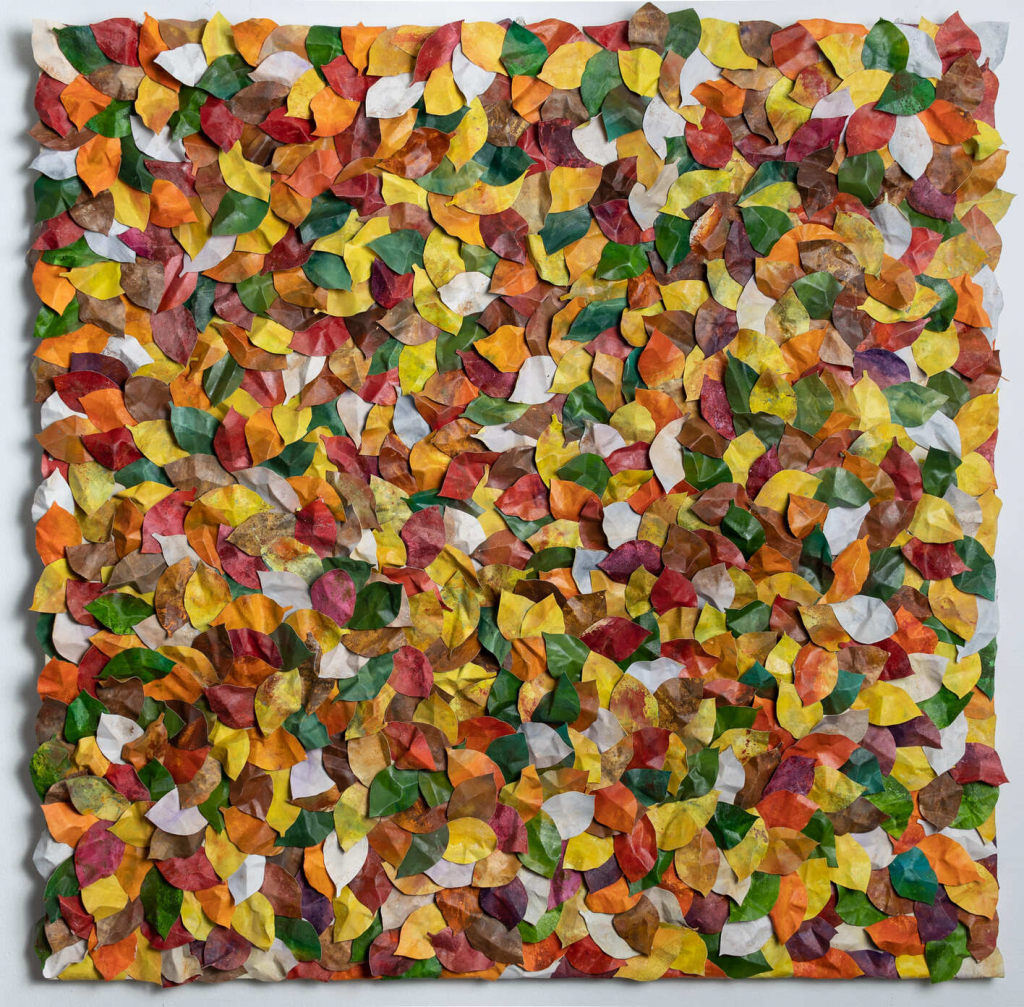
dove le tonalità che contraddistinguono le foglie sembrano essere note di introspezione che si muovono al ritmo calmo del percorso di autoconsapevolezza delle proprie esigenze. Nel lavoro Sincronicità

invece Daniela Rebuzzi usa il filato di varie tonalità attraverso il quale tesse una fitta trama con cui descrive le interazioni costanti a cui è sottoposto l’uomo contemporaneo pur osservando solo distrattamente l’altro, quasi come se il suo esserci fosse solo un dettaglio trascurabile poiché non utile al proprio frenetico cammino troppo spesso votato all’arrivismo. In un tale contesto di individualismo si perde di vista l’altro come persona, come essere emozionale con una vita a volte piena a volte infelice, esattamente come la nostra, e un punto di vista più empatico sarebbe sufficiente a ricostruire una società più sana. Andiamo ora a scoprire di più di questa innovativa artista.
Daniela, lei ha compiuto la scelta di riconciliare le sue due anime, quella più pragmatica e pratica che emerge nella sua professione, e quella più morbida e sensibile che trova realizzazione nell’espressione artistica. Qual è stato il momento o l’episodio che le hanno fatto capire di dover dare voce anche al suo lato più introspettivo e creativo?
Forse per trovare il mio equilibrio interiore ho sempre conciliato l’anima più pragmatica e pratica, che mi deriva dalla professione, alla parte più sensibile ed emozionale che scaturisce dal mio lato artistico. Ho sempre, come credo tutti, cercato di mantenermi in equilibrio tra l’emisfero destro e quello sinistro per trovare il mio centro, il mio bilanciamento, e dunque credo siano stati la mia filosofia di vita e il mio cammino spirituale a portarmi verso la manifestazione artistica. Forse però c’è stato un episodio specifico che mi ha proiettata verso la parte creativa, che ho sempre avuto latente ma che ho accantonato quando ho deciso di intraprendere la carriera in ambìto finanziario e poi di dedicarmi alla famiglia, e cioè il giorno di qualche anno fa in cui sono andata per caso in cantina con il mio figlio più grande e lui ha visto il cavalletto e le mie tele; è rimasto sorpreso e mi ha incoraggiata a riprendere a dedicarmi di nuovo all’arte. Da quel momento in avanti ho cominciato a lasciar emergere il mio lato artistico in modo più concreto.
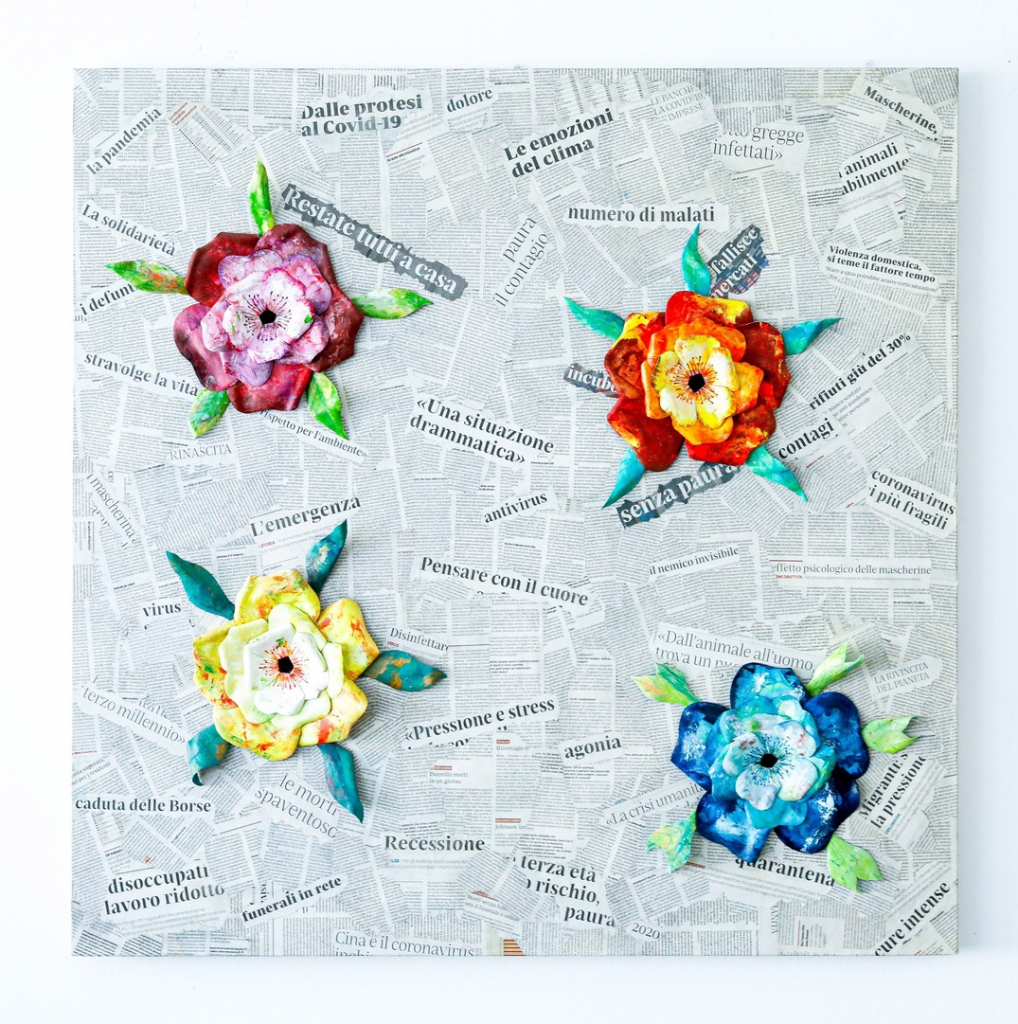
Quanto sono stati determinanti i viaggi nel suo approccio aperto e possibilista alla realtà esistenziale? Ha trovato ispirazione anche nei colori e nei diversi stili di vita e di interpretazione dell’oggettività nelle culture con cui è entrata in contatto?
I viaggi che ho fatto sono stati incredibilmente determinanti perché nei paesi visitati ho trovato molta ispirazione, sia a livello cromatico che dal punto di vista dei profumi, dei sapori, degli usi e dei costumi. Sono state esperienze molto importanti e arricchenti perché ho avuto modo di entrare in contatto con culture diverse e affascinanti, in cui le tradizioni sono più radicate rispetto a quelle dei paesi occidentali e ognuno dei luoghi visitati ha lasciato una traccia profonda. In India ho scoperto e studiato la pittura in miniatura e la tessitura, in Giappone ho imparato a utilizzare la tecnica del shodo, che è l’arte calligrafica, che mi ha ispirata per l’approccio meditativo al primo impatto alla tela. Ci sono stati viaggi grazie ai quali ho visitato la Siberia, sono entrata in contatto con la cultura shiamanica, e poi ancora con le popolazioni berbere dell’Africa, dove ho approfondito la simbologia così come le origini di quel continente. In ogni viaggio porto il mio taccuino dove appunto le emozioni ma anche gli insegnamenti, artistici e pratici, che ricevo da quelle culture lontane. Esperienze fondamentali per alimentare i miei progetti artistici, non solo quelli legati alla pittura e la scultura ma anche quelli legati alla scrittura.
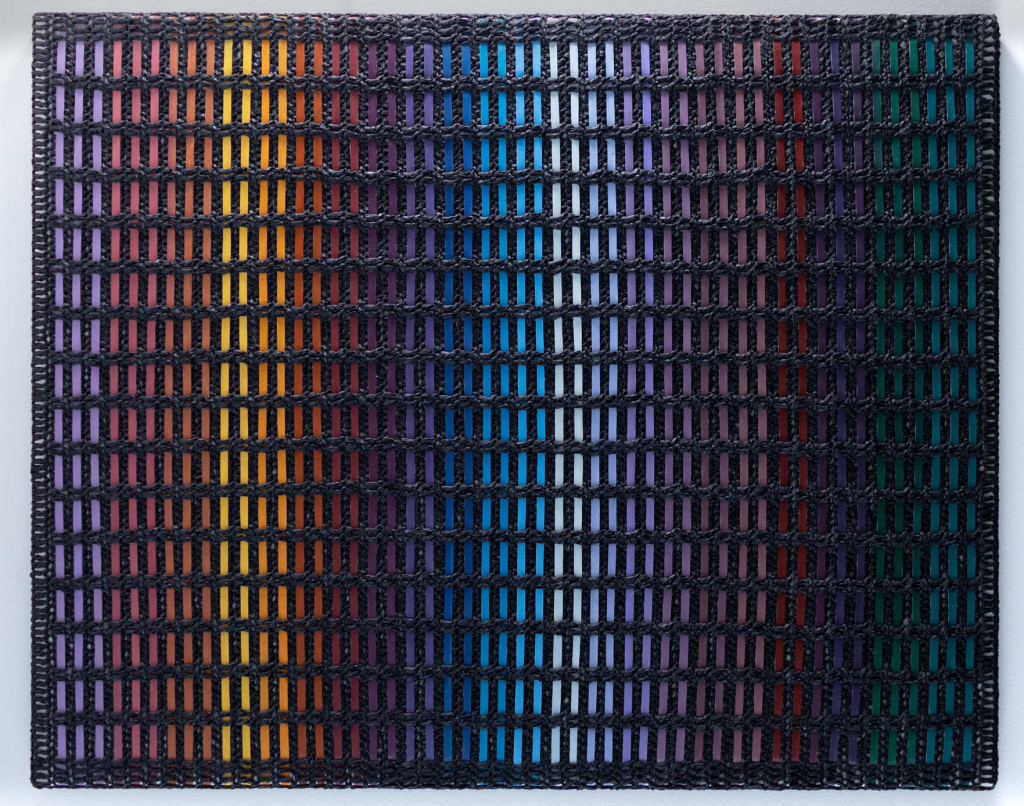
Lei usa la materia in modo inconsueto, letteralmente trasformandone l’illusione della struttura ingannando lo sguardo che crede di trovarsi davanti a una superficie solida e immobile mentre in realtà la consistenza è ben diversa; a cosa è dovuta la scelta di questo singolare linguaggio artistico? Qual è il messaggio che vorrebbe trasmettere all’osservatore?
È vero, uso la materia in modo insolito, la trasformo, per creare una sorta di illusione, di mutazione, per riallacciarmi alla mia filosofia del cammino della nostra anima che è strettamente connesso con la nostra metamorfosi interiore quindi è uno stimolo ad avere una visione, ad aprirci a qualcosa che va oltre il visibile, va oltre il cognitivo e vibra a un livello profondo portandoci verso le nostre emozioni e ci conduce verso la guarigione interna ed esterna. Credo che l’arte in generale abbia una grande forza intrinseca di cura e di guarigione, ed è forse proprio questo il messaggio che vorrei arrivasse ai fruitori delle mie opere.
A quali maestri del passato si ispira? Si può avvicinare il suo approccio in qualche modo anche alla Recycling Art, considerando l’attitudine a dare nuova vita a materiali nati per tutt’altro scopo come ritagli di giornale, piume, post-it che diversamente verrebbero semplicemente gettati nella spazzatura? C’è una filosofia ambientalista dietro la sua scelta artistica?
Ho sempre molto letto tanto sull’arte del passato e durante i numerosi viaggi mi ritagliavo sempre del tempo per visitare i grandi musei disseminati per il mondo e ogni volta che entravo e mi trovavo davanti alle opere dei grandi maestri mi sono sentita connessa a ognuno di loro per determinate e diverse particolarità, mi sentivo vicina in ciò che loro osservavano o da cui erano ispirati. Per esempio il trasformismo di Francis Bacon lo trovo affine al mio modo di fare arte, malgrado il suo sia un linguaggio più figurativo; alla visione futuristica di Pablo Picasso mi sento vicina per la mia spinta a osare e destrutturare. E ancora Klee mi ispira per il suo amore per la natura tanto quanto con Dalì sento un legame per quanto riguarda il suo approccio onirico, essendo per me il mondo dei sogni oggetto di studio anche insieme a gruppi con cui facciamo esperimenti sui sogni collettivi. E poi la distorsione della realtà di René Magritte a cui mi sento vicina per il suo messaggio, sul concetto di spingersi oltre la realtà. E infine con Nicki de Saint Phalle trovo un punto comune nella lettura della vita attraverso la leggerezza. Per quanto riguarda invece la Recycling Art, malgrado di fatto io utilizzi materiali non tradizionalmente appartenenti alla pittura e dunque dando una vita diversa a ciò che normalmente avrebbe un altro uso, di fatto non mi sento vicina a quel tipo di arte, o quanto meno non è nella mia intenzione creativa quella di mettere in evidenza temi e filosofie ambientaliste; il concetto in sé forse fuoriesce con messaggi più sottili ma non è l’obiettivo primario del mio modo di fare arte.

Lei ha al suo attivo mostre in Svizzera, sua nazione di residenza, e all’estero – Italia, Francia, Gran Bretagna, Spagna, Emirati Arabi, Austria e al di là dell’oceano, negli Stati Uniti, a Miami e New York. Quali sono i suoi prossimi progetti?
Quest’anno ho partecipato ad Arte Bergamo con la galleria Malimpensa di Torino, poi a una mostra collettiva a Pieve di Urago Mella, e dopo la fine dell’estate ho in programma una mostra a Lucerna, in una location molto bella in centro città; in realtà però quest’anno mi sono concentrata di più sullo sviluppo di nuove tecniche, di nuovi progetti artistici che mi porteranno a organizzare una mostra personale in Svizzera, presso una struttura gestita da una Fondazione, di cui non voglio anticipare troppo. Mi sono dedicata molto allo studio, infatti mi sono iscritta a un Master in Counseling sistemico cognitivo, e a un progetto editoriale legato a un romanzo che ho appena finito di scrivere e spero sarà pubblicato entro fine anno. E visto che il mio dinamismo è inarrestabile, sto sviluppando con alcuni gruppi del mio territorio un progetto di aiuto attraverso l’approccio all’arte che non è legato all’Arteterapia bensì è concepito sviluppando altre tecniche.
DANIELA REBUZZI-CONTATTI
Email: info@danielarebuzzi.ch
Sito web: www.danielarebuzzi.ch
Facebook: https://www.facebook.com/daniela.rebuzzi.7
Instagram: https://www.instagram.com/daniela_rebuzzi/
Marta Lock’s interviews: Daniela Rebuzzi, art as a bridge to reconcile her inner opposites
The choice to live immersed in nature, on the shores of Lake Lugano, allowed her to place herself in a position of listening to her inner self, the one that induced her to seek a way out of the logic and rigidity of her role as a financial professionist, to run towards a more spiritual approach, more predisposed to reflection and attention on everything that escapes the mind and order to enter the fascinating and enthralling world of chaos. It was the silence of the places where she lives, the tranquillity of the waters on which the mountains are reflected, that induced her to free her creative side, as well as her poetic one, which in the professional sphere could not be realised, making her perceive that subtle dissatisfaction that sooner or later leads to a natural inclination that cannot go unheeded; despite the discovery of a sensitive and creative nature, however, Daniela Rebuzzi’s approach to art is more reflective and analytical rather than impulsively impetuous, so the technique she chooses is that of the Materic Informal, where matter seems to constitute the medium through which she breaks down the observed reality and its habitual consistency and then recomposes it according to her own emotional but also meditative scheme, as if it somehow felt the need to show the observer, and in the end even herself, how many possibilities exist if only one is able to get out of one’s own unique point of view, out of the straight line on which the individual often tends to channel his existence, avoiding venturing into different paths that might even prove better, despite the initial destabilisation. Every type of material constitutes an expressive channel for Rebuzzi, a way of transforming everything into something different from its original form, enriching poor objects taken from everyday life with concepts after their use has been exhausted, because it is precisely from everything familiar that contemporary man can take his cue to embrace a different vision, can become aware that the meaning attributed by rationality and the signifier understood as the starting point for the exploration of reality, can be completely and surprisingly different from the common imagination. Her passion for travelling has brought her into contact with civilisations opposite to the one in which she was born and this has allowed her to observe in an open and receptive manner how every truth, every certainty, is subject to interpretation and can have a meaning unthought of until before coming into contact with cultural diversity; in the same way, in those journeys of knowledge, she has collected notes of sensations, as well as materials typical of those faraway places, which she has then meditated on and explored at length until being translated into those singular and structured pictosculptures, where the part in relief, the part that interacts with the surrounding space, does not have the rigid and solid consistency of the materials usually used in sculpture, but belongs to the world of softness, malleability and therefore of possibilism. Painted leaves that form a soft surface, almost as if to protect the hardness of an existence that is too tied to logic and formalism, and that seem to invite the observer to take note of the need to stop and listen to that more melodic part constituted by the soul, by an inner depth that manages to emerge only when the rational mind shuts down, even if only for a moment; this is the meaning of the artwork Silentium where the tones that mark the leaves seem to be notes of introspection that move to the calm rhythm of the path of self-awareness of one’s own needs. In the work Synchronicity, on the other hand, Daniela Rebuzzi uses the yarn of various shades through which she weaves a dense weft with which she describes the constant interactions to which contemporary man is subjected while only distractedly observing the other, almost as if his being there were only a negligible detail since it is not useful to his own frenetic path all too often devoted to arrivism. In such a context of individualism, we lose sight of the other as a person, as an emotional being with a life that is sometimes full and sometimes unhappy, just like our own, and a more empathetic point of view would be sufficient to rebuild a healthier society. Let us now find out more about this innovative artist.
Daniela, you have made the choice to reconcile your two souls, the more pragmatic and practical one that emerges in your profession, and the softer and more sensitive one that finds fulfilment in artistic expression. What was the moment or episode that made you realise that you also had to give voice to your more introspective and creative side?
Perhaps in order to find my inner balance, I have always reconciled the more pragmatic and practical soul, which comes from my profession, with the more sensitive and emotional part that springs from my artistic side. I have always, as I believe everyone else, tried to keep my right and left hemispheres in balance to find my centre, my equilibrium, and so I believe it was my philosophy of life and my spiritual path that led me towards artistic manifestation. However, perhaps there was a specific episode that projected me towards the creative side, which I always had latent but which I set aside when I decided to pursue a career in finance and then to dedicate myself to my family, and that was the day of a few years ago when I went by chance to the basement with my eldest son and he saw the easel and my canvases; he was surprised and encouraged me to take up art again. From that moment on, I started to let my artistic side emerge in a more concrete way.
How decisive were journeys in your open and possibilistic approach to existential reality? Did you also find inspiration in the colours and different lifestyles and interpretations of objectivity in the cultures you came into contact with?
The journeys I made were incredibly decisive because I found a lot of inspiration in the countries I visited, both in terms of colours and from the point of view of scents, flavours, customs and habits. They were very important and enriching experiences because I was able to come into contact with different and fascinating cultures, where traditions are more deeply rooted than in Western countries, and each of the places I visited left a deep mark. In India, I discovered and studied miniature painting and weaving, in Japan, I learnt how to use the shodo technique, the art of calligraphy, which inspired me for its meditative approach to the canvas. There were trips where I visited Siberia, came into contact with the shamanic culture, and then again with the Berber peoples of Africa, where I delved into the symbolism as well as the origins of that continent. On each trip I carry my notebook where I write down the emotions but also the teachings, both artistic and practical, that I receive from those distant cultures. These experiences are fundamental to nourishing my artistic projects, not only those related to painting and sculpture but also those related to writing.
You use matter in an unusual way, literally transforming the illusion of structure by deceiving the eye that thinks it is in front of a solid and motionless surface when in fact the consistency is quite different; what is the reason for choosing this singular artistic language? What is the message you would like to convey to the viewer?
It is true, I use the material in an unusual way, I transform it, to create a sort of illusion, of mutation, to reconnect with my philosophy of the journey of our soul which is closely connected with our inner metamorphosis so it is a stimulus to have a vision, to open ourselves up to something that goes beyond the visible, the cognitive, and vibrates at a deep level taking us towards our emotions and leading us towards internal and external healing. I believe that art in general has a great intrinsic healing and curing power, and this is perhaps the message I would like to get across to the viewers of my artworks.
Which masters of the past do you draw inspiration from? Can your approach in some ways also be compared to Recycling Art, considering the attitude of giving new life to materials born for an entirely different purpose such as newspaper cuttings, feathers, post-it notes that would otherwise simply be thrown in the bin? Is there an environmentalist philosophy behind your artistic choice?
I have always read a lot about the art of the past and during my numerous trips I would always carve out time to visit the great museums scattered around the world and every time I entered and found myself in front of the works of the great masters, I felt connected to each of them by certain and different particularities, I felt close to what they observed or were inspired by. For example, Francis Bacon’s transformism I find akin to my way of making art, despite his being a more figurative language; to Pablo Picasso’s futuristic vision I feel close because of my drive to dare and deconstruct. And again Klee inspires me for his love of nature just as much as I feel a bond with Dalì for the oneiric approach, being the world of dreams an object of study for me, even together with groups with whom we do experiments on collective dreams. And then René Magritte’s distortion of reality to which I feel close because of its message, about the concept of going beyond reality. And finally with Nicki de Saint Phalle, I find a common point in the reading of life through lightness. On the other hand, with regard to Recycling Art, despite the fact that I use materials that do not traditionally belong to painting and therefore give a different life to what would normally have another use, I do not actually feel close to that type of art, or at least it is not my creative intention to highlight environmentalist themes and philosophies; the concept itself perhaps comes out with more subtle messages but it is not the primary objective of my way of making art.
You have exhibitions to your credit in Switzerland, your country of residence, and abroad – Italy, France, Great Britain, Spain, the Arab Emirates, Austria and across the ocean, in the United States, in Miami and New York. What are your next projects?
This year I took part in Arte Bergamo with the Malimpensa Gallery of Turin, then in a group exhibition in Pieve di Urago Mella, and after the end of the summer I am planning an exhibition in Lucerne, in a very beautiful location in the city centre; however, this year I have actually concentrated more on developing new techniques, new artistic projects that will lead me to organise a personal exhibition in Switzerland, at a structure managed by a Foundation, which I do not want to anticipate too much about. I have dedicated myself a lot to studying, in fact I have enrolled in a Master’s degree in Cognitive Systemic Counselling, and to a publishing project related to a novel that I have just finished writing and I hope will be published by the end of the year. And since my dynamism is unstoppable, I am developing with some groups in my area a project to help through an approach to art that is not related to Art Therapy but is conceived by developing other techniques.

